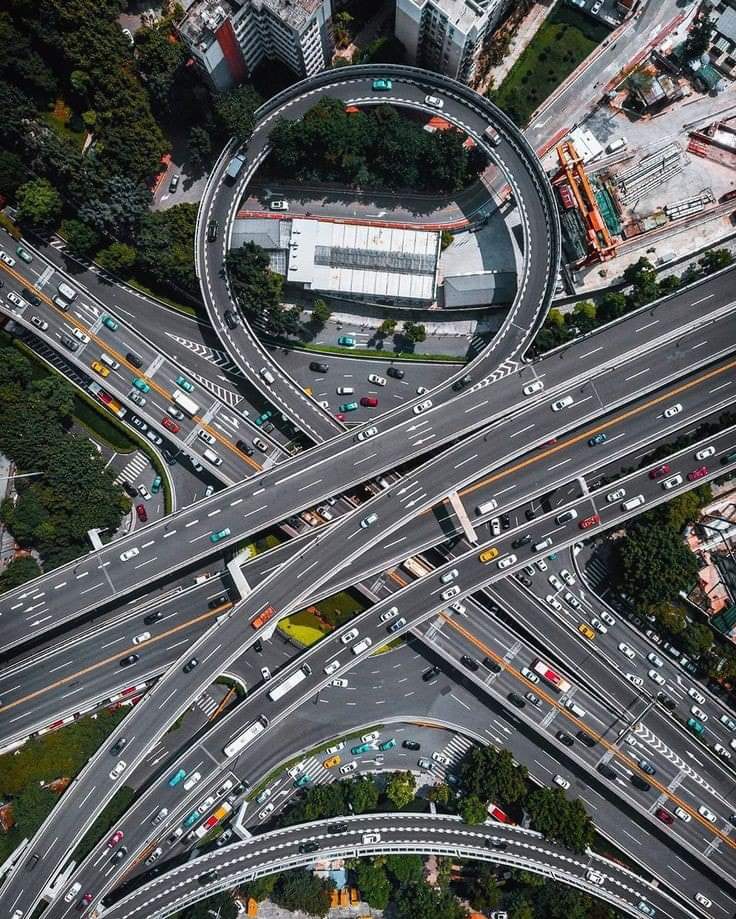AMAZING INFRASTRUCTURE: The Captivating Transport Network of China's Guangzhou City

Did you know that Guangzhou City's transport network which has several connections to the metro is the world's 2nd-largest Bus Rapid Transit (BRT) system with 1,000,000 passenger trips daily?
Guangzhou, the capital and largest city of Guangdong province in southern China, is located on the Pearl River about 120 kilometers (75 miles) north-northwest of Hong Kong and 145 km (90 mi) north of Macau, Guangzhou, with an history of over 2,200 years. It boast of an amazing network of roads and flyovers, whose beauty comes alive when pictured from an aerial view. When the first line of the Guangzhou Metro opened in 1997, Guangzhou was the fourth city in Mainland China to have an underground railway system, behind Beijing, Tianjin, and Shanghai.
Currently the metro network is made up of 16 lines, covering a total length of 652.81 km (405.64 mi). A long-term plan is to make the city's metro system expand to over 500 km (310 mi) by 2020 with 15 lines in operation. In addition to the metro system there is also the Haizhu Tram line which opened on December 31, 2014.
The Guangzhou Bus Rapid Transit (GBRT) system was introduced in 2010 along Zhongshan Road. It has several connections to the metro and is the world's 2nd-largest bus rapid transit system with 1,000,000 passenger trips daily. It handles 26,900 pphpd (passengers per hour per direction) during the peak hour a capacity second only to the TransMilenio BRT system in Bogota. The system averages one bus every 10 seconds or 350 per hour in a single direction and contains the world's longest BRT stations—around 260 m (850 ft) including bridges.
In the 19th century, the city already had over 600 long, straight streets; these were mostly paved but still very narrow. In June 1919, work began on demolishing the city wall to make way for wider streets and the development of tramways. The demolition took three years in total. In 2009, it was reported that all 9,424 buses and 17,695 taxis in Guangzhou would be operating on LPG-fuel by 2010 to promote clean energy for transport and improve the environment ahead of the 2010 Asian Games which were held in the city. At present, Guangzhou is the city that uses the most LPG-fueled vehicles in the world, and at the end of 2006, buses and taxis numbering 6,500 and 16,000 respectively were using LPG, taking up 85 percent of all buses and taxis.
Effective January 1, 2007, the municipal government banned motorcycles in Guangdong's urban areas. Motorcycles found violating the ban are confiscated. The Guangzhou traffic bureau claimed to have reported reduced traffic problems and accidents in the downtown area since the ban.
In rail transport, Guangzhou is the terminus of the Beijing–Guangzhou, Guangzhou–Shenzhen, Guangzhou–Maoming and Guangzhou–Meizhou–Shantou conventional speed railways. In late 2009, the Wuhan–Guangzhou high-speed railway started service, with multiple unit trains covering 980 km (608.94 mi) at a top speed of 320 km/h (199 mph). In December 2014, the Guiyang–Guangzhou high-speed railway and Nanning-Guangzhou railway began service with trains running at top speeds of 250 km/h (155 mph) and 200 km/h (124 mph), respectively. The Guangdong Through Train departs from the Guangzhou East railway station and arrives at the Hung Hom station in Kowloon, Hong Kong. The route is approximately 182 km (113 mi) in length and the ride takes less than two hours. Frequent coach services are also provided with coaches departing every day from different locations (mostly major hotels) around the city. A number of regional railways radiating from Guangzhou started operating such as the Guangzhou–Zhuhai intercity railway and the Guangzhou-Foshan-Zhaoqing intercity railway.
In modern commerce, Guangzhou is best known for its annual Canton Fair, the oldest and largest trade fair in China. For three consecutive years (2013–2015), Forbes ranked Guangzhou as the best commercial city in mainland China. It is also highly ranked as an Alpha (global first-tier) city together with San Francisco and Stockholm. It is a major Asia-Pacific finance hub, ranking 21st globally in the 2020 Global Financial Centres Index.
As an important international city, Guangzhou has hosted numerous international and national sporting events, the most notable being the 2010 Asian Games, the 2010 Asian Para Games, and the 2019 FIBA Basketball World Cup. The city hosts 65 foreign representatives, making it the major city hosting the third most foreign representatives in China, after Beijing and Shanghai. As of 2020, Guangzhou ranks 10th in the world and 5th in China—after Beijing, Shanghai, Hong Kong and Shenzhen—for the number of billionaire residents by the Hurun Global Rich List. It was a major terminus of the Silk Road.
Guangzhou is also a major Asia-Pacific research and development hub with a high level of scientific research output, ranking 8th globally and 4th in the Asia-Pacific, and is home to many of China's most prestigious universities, including Sun Yat-sen University, South China University of Technology, Jinan University, South China Normal University, South China Agricultural University, Guangzhou University, Southern Medical University, Guangdong University of Technology, Guangzhou Medical University, and Guangzhou University of Chinese Medicine.
PhotoCredit: X @CivilEngDis Civil Engineering Discoveries
#penglobalfactfile


_1755775186.jpg)
